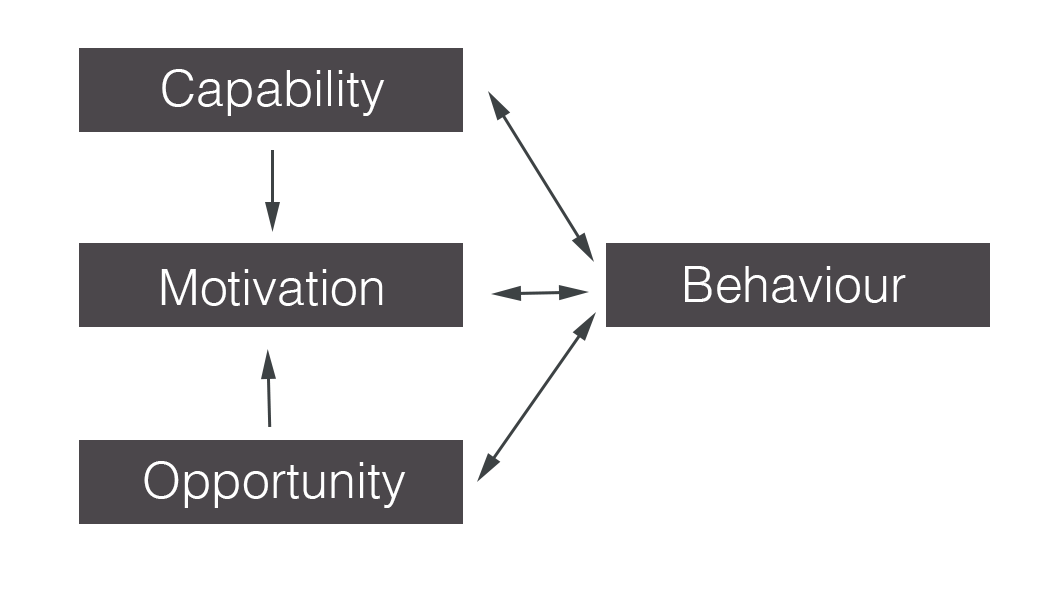
How can understanding behaviour help us address common challenges and plan activities to create positive system-wide changes?
We have been exploring the activities of 'data access initiatives', as part of our Data infrastructure for common challenges project. Data access initiatives are programmes of work that aim to address a specific challenge by increasing access to data. You can read more about them in an earlier blog post from the team.
One of the key questions we’ve been considering is how these initiatives identify what data infrastructure they need to build to address a range of social, environment or economic challenges.
This article is part of a short series that shares how a range of tools and frameworks might help us to design impactful initiatives.
In this post, we look at the role of behaviour change.
Why is understanding behaviour change important for data access initiatives?
In a previous article, we discussed the importance of being able to understand how a particular system works in addressing the common challenges faced by the stakeholders. Thinking about a system can help us to examine its current condition. It can also help identify gaps in the system, and therefore opportunities to create positive changes, such as building data infrastructure, creating diverse partnerships and improving equity in decision-making processes.
There is a logical path of progression that any system needs to take to create these positive changes. This involves planning and undertaking a set of activities around accessing, using and sharing data to produce useful outputs which lead to creating positive outcomes and ultimately, impact. Logic models can be useful in helping us to plan these activities and outputs to achieve these longer-term goals.
For many systems, simple changes in how data is being collected, shared and used could make a huge difference. For example, in our research into private sector data sharing, we found that there can be a number of benefits for businesses when they share data, but more often than not, businesses are reluctant to change from their business-as-usual approach. When the current activities that are being undertaken by people within a system do not contribute to creating a positive impact, it may be necessary to change these behaviours. Understanding how to effectively change behaviour can be useful in these scenarios.
What factors influence our behaviour?
At the ODI, we’ve been using the COM-B Behaviour Change Model to help us understand the different influences that drive behaviour and ultimately inform the decisions that people make. We’ve used the COM-B model to describe behaviour change in several of our projects, including in our joint insight report on sharing engineering data with Lloyd’s Register Foundation.
The COM-B model describes three influences on behaviour:
- Capability. An individual or system’s physical and psychological skills, knowledge and ability to act in a certain way.
- Opportunity. External factors which enable or inhibit certain behaviours. Influences include physical opportunities, such as time, location and resources, as well as social opportunities, like cultural norms and accepted behaviours.
- Motivation. A set of internal processes that influence behaviour. This consists of automatic processes, such as desire or aversion, and reflective processes, based on our evaluation of past events.

COM-B Behaviour Change Model (Mitchie et al. 2011)
Although all three factors can have a direct influence on behaviour, motivation is considered to be the main driver for behaviour changes, with our perception of our capability and available opportunity usually influencing our motivation to act in a certain way, rather than the behaviour itself. The outcome of our behaviours can also contribute to changes in capability, motivation and opportunity as well.
Using the COM-B model can help those working in data access initiatives to think about how they could create outputs that enable people to change their behaviour. This then can lead to better decision making and helps to create the desired impact.
Data access initiatives are inherently designed to create positive systemic change, and the way that they do this is to enable actors within the system to change their behaviour for the better. Our research to date indicates that the most successful data access initiatives aim to improve capability or increase opportunities to change behaviours.
Let’s take two different examples of data access initiatives and compare how both have approached changing behaviour in their respective systems. Below we have some of the activities from OpenActive – an initiative which aims to make it easier for people to find physical activities – compared against some of the activities from Open Banking – an initiative which aims to help banking customers to switch accounts more easily, therefore making the banking sector more competitive.
[table id=26 /]
As shown in the table above, although both initiatives are grounded in different sectors and have faced very different challenges, they have both taken a fairly similar approach to changing behaviour.
Both initiatives are increasing capability by creating tools and guidance for their respective sectors, and in addition, the OpenActive initiative is providing training to industry experts to help them to drive change in their local area.
Each initiative is increasing the opportunity for innovators to create products and services by publishing open data. OpenActive does this by working with physical activity providers, while in the Open Banking initiative, larger banks are required to publish certain datasets by law.
Equally, motivation is being built in a very similar way for both initiatives. Innovators are being afforded the opportunity to build new products and services and to secure some financial gain through challenge programmes, and both physical activity providers and banks are able to reach new customers through these third party services.
---
We would love to hear from you about how you are applying the COM-B model to your data initiatives. Also, please get in touch if you would like to discuss any of these ideas to understand how the COM-B model, or other behaviour change approaches, might help.